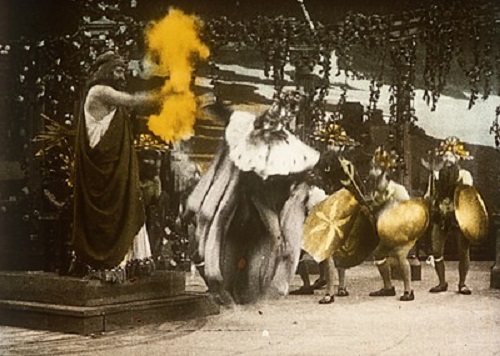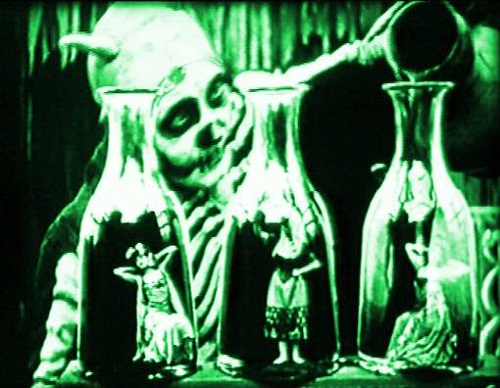Segundo de Chomón: Forgotten Fantasist of Silent Film

Fantasy, science fiction, and horror themes have been in the movies since almost the beginning. During the first few experimental years, movies consisted of simple scenes such as a man sneezing or a train pulling into the station, but soon that novelty wore off and audiences wanted stories. Since the medium itself seemed almost magical, directors began to experiment with the fantastic in order to tell gripping tales.
Most film buffs know of Georges Méliès and his 1902 Trip to the Moon, generally considered the first science fiction film. Méliès started out as a stage magician so it’s not surprising he added an element of the fantastic in his pioneering movies. Other early filmmakers such as Auguste and Louis Lumière and Thomas Edison tended to film realistic subjects or historical/adventure stories, although Edison did make a version of Frankenstein in 1910.
Lost amid these famous names is a man who did as much for the development of fantastic film as any of them. The Spanish director Segundo de Chomón pioneered many early special effects techniques and worked on some two hundred films. Having spent much of his career in France and Italy, he’s been claimed by no country and thus has fallen through the cracks of history.
Born in Teruel in 1871, Segundo de Chomón first came to the movies via his wife, Julienne Mathieu, who was an actress in early silent French films. By 1900, he and his wife were hand-painting films for Méliès and the Pathé brothers, a craft for which he became a master. Film was in its infancy and most people involved in it were experimenters as well. Segundo de Chomón was no exception and built his own camera and developed one of the earliest film tinting processes, which you can see in the documentary Viaje a Burgos (Trip to Burgos) from 1911 and many others. The Pathé brothers later marketed Chomón’s technique as Pathécolor.

Much of Segundo de Chomón’s output was for the Pathé brothers. His first two films were short documentaries in the style of the time, but for Pathé he soon branched out. His third film, in 1902, was El Hada Primavera (The Spring Fairy), in which a couple bring an old woman in from a blizzard and feed her. She then reveals herself as the Fairy of Spring. Chomón adds a sense of wonder to this scene by coloring only her. She then steps out and stops the snow and brings spring to the land, bringing forth colored flowers and giving a special gift to the couple.

As Chomón gained confidence with the new medium, he moved beyond simple hand tinting and tried various other special effects. He is widely credited with being the inventor of stop-motion animation, which can be seen in many of his films, most notably La Casa Encantada (The Haunted House) from 1907 and El Hotel Eléctrico (The Electric Hotel) from 1908. The first of these is a typical haunted house story, complete with travelers seeking shelter from the rain in an abandoned house. Soon things start to move in the house, flames dance around, and a ghost appears through an early use of the split screen technique, which he used to good effect in another 1907 film, Satan se divierte (Satan at Play) in 1907. The Electric Hotel is perhaps Chomón’s best use of stop-motion animation and shows a futuristic hotel where everything is done for you through the power of electricity.

Chomón experimented with other tricks too. In in 1907 film Los Kiriki, Acróbatas Japoneses (The Kiriki, Japanese Acrobats), he makes the acrobats do seemingly impossible tricks by using a special camera angle. Watch the film and see if you can figure it out.
While Pathé enjoyed commercial success, they weren’t above copying their competitors. In 1909, Chomón did a direct ripoff of Méliès’ masterpiece with Excursion a la Luna. While it copies the earlier film almost scene for scene, it lacked the elaborate stage designs of the original, although it has a few extra tricks. A better effort is the more visually appealing Viaje a Júpiter (Voyage to Jupiter) from the same year.
Chomón continued to work on films until his death in 1929. In his later years, he left directing and focused on doing special effects. His contributions can be seen in two landmark silent films, Cabiria (1914), and Napoleon (1927). His earliest films are the most charming, however. Film was barely two decades old and everything was still experimental, and Segundo de Chomón churned out a vast amount of clever, beautiful films. Early films tended to be single six-minute reels. Two-reel movies were the exception in the first decade of the twentieth century. This makes these classic old films a perfect break at work. Click on the links and enjoy!
Sean McLachlan is a freelance travel and history writer. He is the author of the historical fantasy novel A Fine Likeness, set in Civil War Missouri, and the post-apocalyptic thriller Radio Hope. His historical fantasy novella The Quintessence of Absence, was published by Black Gate. Find out more about him on his blog and Amazon author’s page.
All images in the public domain.